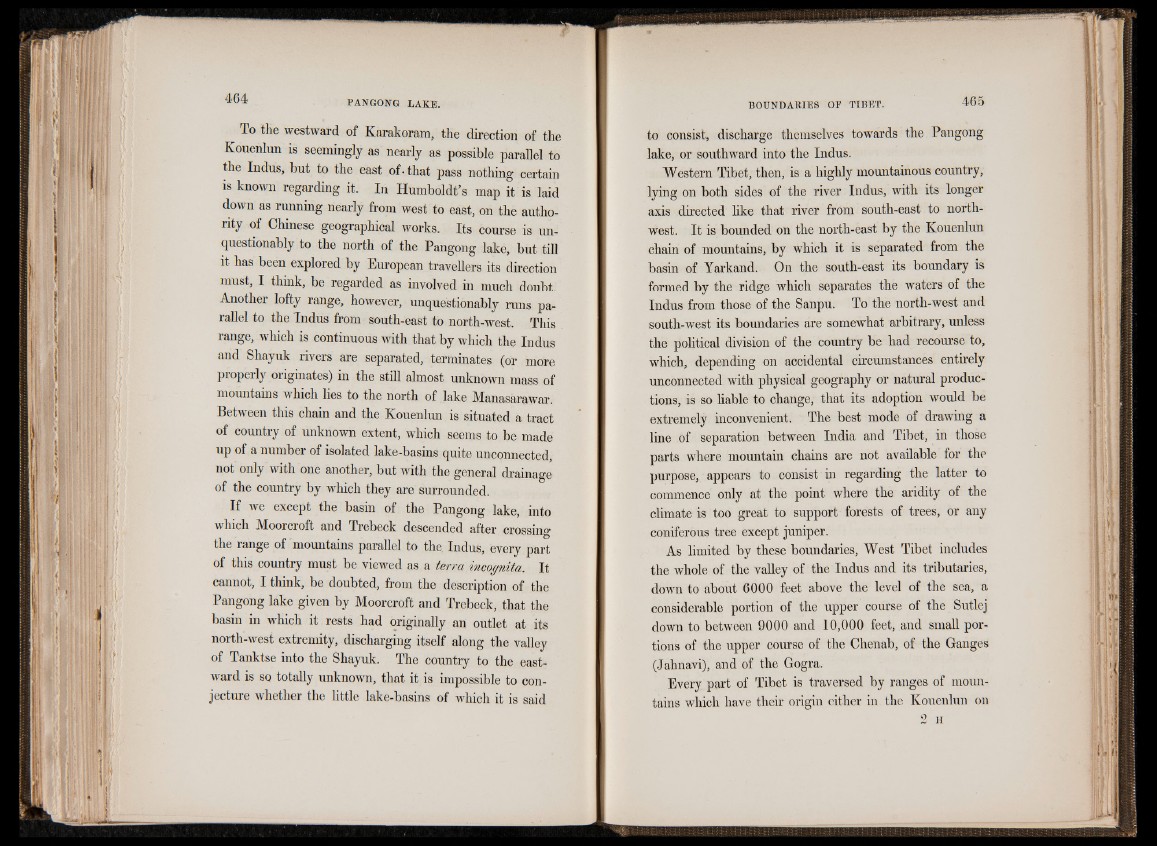
To the westward of Karakoram, the direction of the
Kouenlun is seemingly as nearly as possible parallel to
the Indus, but to the east of - that pass nothing certain
is known regarding it. In Humboldt’s map it is laid
down as running nearly from west to east, on the authority
of Chinese geographical works. Its course is unquestionably
to the north of the Pangong lake, but till
it has been explored by European travellers its direction
must, I think, be regarded as involved in much doubt.
Another lofty range, however, unquestionably runs parallel
to the Indus from south-east to north-west. This
range, which is continuous with that by which the Indus
and Shayuk rivers are separated, terminates (or more
properly originates) in the still almost unknown mass of
mountains which lies to the north of lake Manasarawar.
Between this chain and the Kouenlun is situated a tract
of country of unknown extent, which seems to be made
up of a number of isolated lake-basins quite unconnected,
not only with one another, but with the general drainage
of the country by which they are surrounded.
If we except the basin of the Pangong lake, into
which Moorcroft and Trebeck descended after crossing
the range of mountains parallel to the Indus, every part
of this country must be viewed as a terra incognita. It
cannot, I think, be doubted, from the description of the
Pangong lake given by Moorcroft and Trebeck, that the
basin in which it rests had originally an outlet at its
north-west extremity, discharging itself along the valley
of Tanktse into the Shayuk. The country to the eastward
is so totally unknown, that it is impossible to conjecture
whether the little lake-basins of which it is said
to consist, discharge themselves towards the Pangong
lake, or southward into the Indus.
Western Tibet, then, is a highly mountainous country,
lying on both sides of the river Indus, with its longer
axis directed like that river from south-east to northwest.
It is bounded on the north-east by the Kouenlun
chain of mountains, by which it is separated from the
basin of Yarkand. On the south-east its boundary is
formed by the ridge which separates the waters of the
Indus from those of the Sanpu. To the north-west and
south-west its boundaries are somewhat arbitrary, unless
the political division of the country be had recourse to,
which, depending on accidental circumstances entirely
unconnected with physical geography or natural productions,
is so liable to change, that its adoption would be
extremely inconvenient. The best mode of drawing a
line of separation between India and Tibet, in those
parts where mountain chains are not available for the
purpose, appears to consist in regarding the latter to
commence only at the point where the aridity of the
climate is too great to support forests of trees, or any
coniferous tree except juniper.
As limited by these boundaries, West Tibet includes
the whole of the valley of the Indus and its tributaries,
down to about 6000 feet above the level of the sea, a
considerable portion of the upper course of the Sutlej
down to between 9000 and 10,000 feet, and small portions
of the upper course of the Chenab, of the Ganges
(Jahnavi), and of the Gogra.
Every part of Tibet is traversed by ranges of mountains
which have their origin cither in the Kouenlun on
2 H